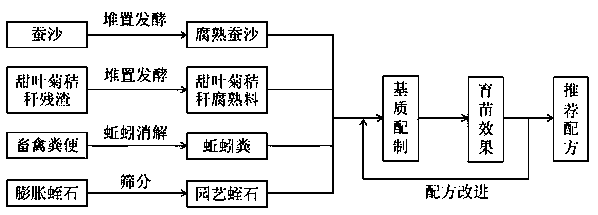Plug seedling substrate for watermelons and preparation method of plug seedling substrate
A technology for raising seedlings in plug trays and watermelons, which is applied in the field of preparation of raw materials and formulations for substrates for raising seedlings in watermelon plug trays, can solve problems affecting the sustainable development of watermelon planting industry, and achieve the goals of increasing plant stress resistance, rich nutrition, and increasing crop yield Effect
- Summary
- Abstract
- Description
- Claims
- Application Information
AI Technical Summary
Problems solved by technology
Method used
Image
Examples
Embodiment 1
[0025] A kind of preparation method of watermelon plug seedling raising substrate, the steps are as follows:
[0026] 1) The residues of silkworm excrement and stevia straw were stacked and fermented separately in the early stage to obtain decomposed silkworm excrement and stevia residue decomposed clinker with excellent physical, chemical and biological properties;
[0027] 2) Use livestock and poultry manure as earthworm food to provide an environment suitable for the growth of earthworms, and sieve the vermicompost produced by earthworm treatment into 1-4mm particle size vermicompost;
[0028] 3) Prepare expansive vermiculite with a particle size of 1-3mm;
[0029] 4) Fully mix the decomposed silkworm excrement, stevia residue decomposed material, vermicompost, and expansive vermiculite prepared in steps 1), 2), and 3) to make a watermelon plug seedling substrate (ESEV seedling substrate). The volume percentages are: decomposed silkworm excrement 5-15%, stevia residue deco...
Embodiment 2
[0031] A preparation method of a watermelon plug seedling substrate, the steps of which are the same as in Example 1, and the volume percentage of each component mixed to form a watermelon plug seedling substrate (ESEV1) is: decomposed silkworm excrement 10%, stevia residue decomposed clinker 50% %, vermicompost 20%, expansive vermiculite 20%. That is, the proportion of decomposed silkworm excrement-stevia residue decomposed material-vermicompost-expandable vermiculite of the ESEV1 seedling-raising substrate is 1-5-2-2.
Embodiment 3
[0033] A preparation method of a watermelon plug seedling substrate, the steps of which are the same as in Example 1, and the volume percentage of each component mixed to form a watermelon plug seedling substrate (ESEV2) is: decomposed silkworm excrement 10%, stevia residue decomposed clinker 60% %, vermicompost 20%, expansive vermiculite 10%. That is, the proportion of decomposed silkworm excrement-stevia residue decomposed material-vermicompost-expandable vermiculite of the ESEV2 seedling-raising substrate is 1-6-2-1.
[0034] test:
[0035] 1. Materials and methods
[0036] 1.1 Test materials
[0037] The variety of watermelon is Sumi watermelon, provided by Vegetable Institute of Jiangsu Academy of Agricultural Sciences. Dry the seeds before sowing, remove the unfulfilled seeds, wrap them with clean gauze, soak them in 0.05% potassium permanganate solution for 4 hours, take them out and rinse them with clean water, drain the water, and set aside. ESEV composite matrix,...
PUM
 Login to View More
Login to View More Abstract
Description
Claims
Application Information
 Login to View More
Login to View More - R&D
- Intellectual Property
- Life Sciences
- Materials
- Tech Scout
- Unparalleled Data Quality
- Higher Quality Content
- 60% Fewer Hallucinations
Browse by: Latest US Patents, China's latest patents, Technical Efficacy Thesaurus, Application Domain, Technology Topic, Popular Technical Reports.
© 2025 PatSnap. All rights reserved.Legal|Privacy policy|Modern Slavery Act Transparency Statement|Sitemap|About US| Contact US: help@patsnap.com


